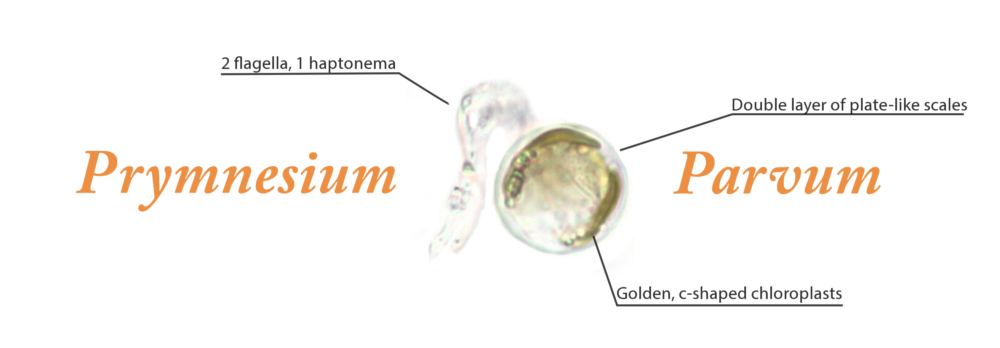
This alga is a mixotroph, meaning it can create energy from photosynthesis as well as consuming organic compounds like nutrients in the water or even bacteria and other prey. It grows, and even prospers, at significantly cooler temperatures than many other algae: ranging from 41-86°F (5-30°C). This allows golden algae to get the jump on growth in the winter and spring, and can allow it to become abundant enough to persist even during the hotter months.
Salinity seems to be the main element controlling P. parvum growth. No growth of the alga has been found in water with a salinity below 0.1% (which is the level of salinity in drinking water) while it’s been known to have huge growth in salinity up to 3% (after 3%, water is considered salt water). Thus, applicators will see P. parvum blooms wiped out after a strong inflow of water or rainfall, both of which can lower salinity.
The Prymnesins
Though golden algae prefer higher salinity, the blooms that occur at lower salinities are more likely to produce the fish-killing toxins golden algae are infamous for: the prymnesins. This is a class of toxins that includes ichthyotoxin, cytotoxin, and a hemolysin, all of which change the permeability of cells specifically in fish. The toxins cause gills to bleed and prevent them from absorbing oxygen, often fatally. Fish hatcheries especially associate golden algae blooms with winter and spring fish kills.
Natural Lake Biosciences Case: Losing fish every winter
In Oklahoma, P. parvum is an annual issue and expensive battle for a 3 acre naturally occurring pond. Its blooms cause multiple fish kills every winter and thousands of dollars were spent on chemicals to control the blooms before the applicators were referred to Natural Lake Biosciences. Testing by our lab identified the alga and revealed that the water was indeed brackish and had some elevated nutrients.
The solution
One of the trickiest aspects of dealing with Prymnesium parvum is that it defies easy answers. After all, salinity is the main element limiting the alga, but it would take an incredible measure to permanently change the salt level of a water body. And, as the applicators of the Oklahoma undoubtedly experienced, using chemicals to kill golden algae can lead to cell lysing—or a breakdown of cells—that can release the toxins within the cells into the water.
Finding a true, lasting solution to Prymnesium parvum and its blooms appears for now to be situation specific and requires some trial and error. For example, using a chemical oxidizer won’t eliminate the algae, but has had some success and limiting the toxicity of it. Another technique calls for precipitating the algae cells out of the water column using the combination of a fine clay and flocculant.
In the case of the Oklahoma pond, our laboratory team proposed a multi-part treatment paired with ongoing analysis as needed. The goal was quick nutrient reduction along with simultaneous algae reduction (there’s some evidence that depriving an existing bloom of nutrients can lead to toxin production). To this end, the lab recommended:
▪ The addition of AquaSticker to the applicators’ tank mix to reduce the quantity of chemicals needed
▪ Water Column Clarifier for immediate fixation of nutrients in the water column
▪ Polar Blend or Summer Slam (depending on water temperatures) for long-term fixation of nutrients in the water column
▪ MD Pellets for elimination of muck and the nutrients that can reside within the muck
Applicators have just begun this treatment, and because golden algae elimination can be so complex, our lab will be in constant contact with them to alter and improve it where necessary. If you’re experiencing issues with golden algae and want to work with our team to find a lasting solution, contact us today.

